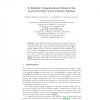Free Online Productivity Tools
i2Speak
i2Symbol
i2OCR
iTex2Img
iWeb2Print
iWeb2Shot
i2Type
iPdf2Split
iPdf2Merge
i2Bopomofo
i2Arabic
i2Style
i2Image
i2PDF
iLatex2Rtf
Sci2ools
84
Voted
IWANN
2001
Springer
2001
Springer
A Realistic Computational Model of the Local Circuitry of the Cuneate Nucleus
Abstract. Intracellular recordings obtained under cutaneous and lemniscal stimulation show that the afferent fibers can establish excitatory and inhibitory synaptic connections with cuneothalamic neurons [5]. In addition, distinct types of recurrent collaterals with the capability of either exciting or inhibiting both cuneothalamic neurons and interneurons were also discovered [6]. With these data we have generated hypothesis about which circuits are implicated and also developed realistic computational models to test the hypothesis and study the cuneate properties [17,18]. The results show that the cuneate could perform spatial and temporal filtering and therefore detect dynamic edges.
Cuneothalamic Neurons | Inhibitory Synaptic Connections | IWANN 2001 | Neural Networks | Realistic Computational Models |
| Added | 30 Jul 2010 |
| Updated | 30 Jul 2010 |
| Type | Conference |
| Year | 2001 |
| Where | IWANN |
| Authors | Eduardo Sánchez Vila, Senén Barro, Jorge Mariño, Antonio Canedo |
Comments (0)

